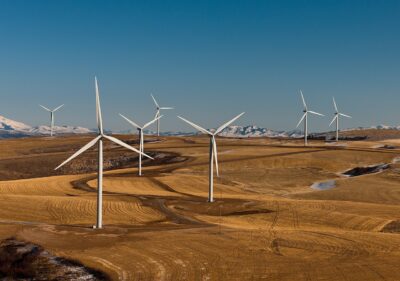How Does Wind Energy Work?
Currently, there are over 48,000 utility-scale wind turbines in the United States. California has the Alta Wind Energy Center, the country’s largest wind farm, but Texas ranks number one for the most installed wind power capacity at 14,098 megawatts (MW). Wind energy is a very viable power source. The U.S. currently has 66 gigawatts (GW) of wind power capacity, exceeded only by China’s 76 GW.

What is wind?
A form of solar energy, atmospheric circulation (global wind) occurs due to two main factors:
- The irregular heating of the Earth’s atmosphere by the Sun
- The Earth’s rotation
Local factors can create and affect wind as well, including differential heating of land and water, elevation change, other temperature gradients, and water evaporation, condensation, and precipitation (thunderstorms).
With all these different global and local factors, speeds and flow patterns of wind can vary widely in different geographical regions. Even across the United States they can be vastly different because of oceans and other bodies of water, the terrain, and even vegetation – or lack thereof. Some areas will be windier than others.
Historically, humanity has harnessed the power of the wind for many useful purposes, most frequently sailing. The first practical windmills, which turn wind energy into mechanical power and were a precursor to wind turbine, were constructed in present-day Afghanistan in the 7th century. Today, wind energy is commonly harvested and used to create electricity.
How do wind turbines work?
Wind turbines are composed of a rotor component (which includes the blades and a central rotating shaft), the generator component (which includes the electric generator and all associated controls necessary to turn mechanical power into electricity), and the structural support (which supports all components and allows the rotor to turn into the wind).
Wind turbines harness energy from wind through the aerodynamic lift generated across rotor blades from passing air. The lifting force over the blades causes the rotor to turn, which in turn spins the generator, which converts harvested energy into electricity
Are there different types of wind turbines?
There are two basic types of wind turbines that are used today:
- Horizontal Axis – These are the wind turbines that you have likely seen. They usually have three blades, although sometimes they only have two. They are placed with their blades facing the wind in order for them to operate correctly.
- Vertical Axis – These wind turbines resemble giant egg beaters. Two main styles of vertical axis wind turbines exist: the Darrieus type is the typical egg beater style and relies on aerodynamic lift, while the Savonius type relies uses scoops (which rely on drag) and is similar to an anemometer.
Wind turbines can also be distinguished by their rotation speed. Older wind turbine installations used to rotate at constant speed so that they could match power line frequency. By allowing variable speed operation, newer turbines can turn at whatever speed generates the most electricity. However, this variable speed capability requires variable frequency grid-tie converters so that the electrical output can match line frequency.
Are there different sizes of wind turbines?
Wind turbines are available in various sizes depending on the desired application. Residential turbines tend to be smaller, around 100 kilowatts or less. They are used to power homes, water pumping, and telecommunications dishes. These applications are usually single turbine installations, and may also be used in conjunction with photovoltaic systems, batteries, and diesel generators. Such systems are called hybrid wind systems and are often found in off grid locales or remote areas where connecting to the utility grid is not possible or practical.
Wind turbine go up in size considerably for utility-scale applications. A typical installation in the U.S. is 1.5 megawatts (MW), while the largest installed tower has an output of 8 MW and a blade diameter of 538 feet. These larger turbines are what you will find grouped together on the wind farms because they are much more cost effective to operate.
Wind energy is an effective form of renewable energy. However, as more states find ways to use it and we see more wind farms cropping up, the need to harness and store this energy in a clean and efficient manner becomes greater.
 " alt="">
" alt="">